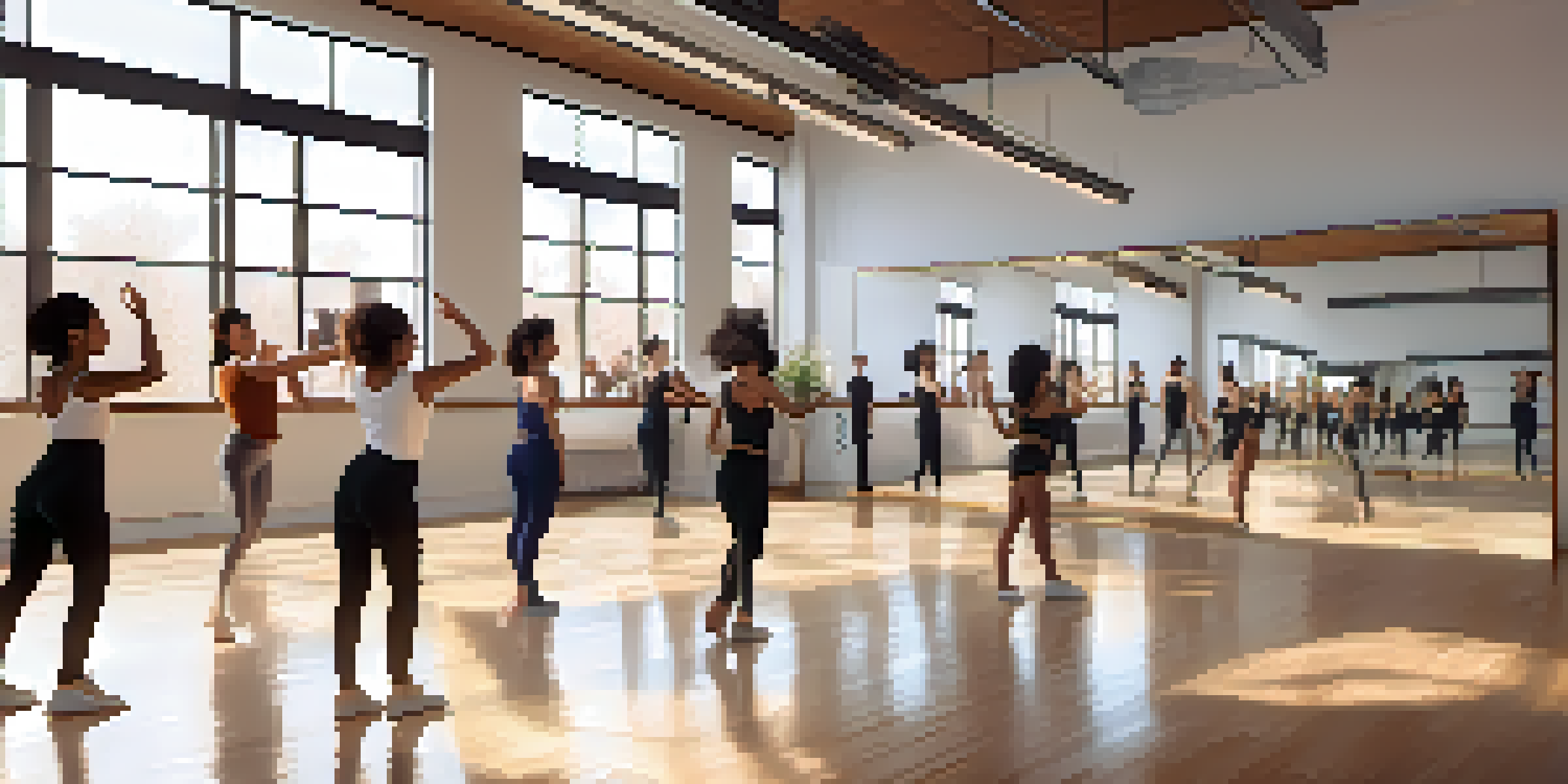Integrating Technology in Dance Education and Pedagogy

Understanding the Role of Technology in Dance Education
Technology has become an integral part of dance education, providing tools that enhance learning and creativity. From video analysis to online tutorials, it allows students to access a wealth of resources at their fingertips. This shift not only democratizes dance education but also caters to diverse learning preferences.
Technology is best when it brings people together.
For instance, students can record their performances and analyze them later, gaining insights into their technique and expression. This immediate feedback loop fosters a culture of self-improvement and accountability. Additionally, technology bridges the gap between students and renowned instructors around the globe, offering a wider range of perspectives.
Moreover, the incorporation of virtual reality and augmented reality can create immersive experiences that bring choreography to life. By visualizing complex movements in a 3D space, students can better understand body mechanics and spatial awareness. This innovative approach makes learning dance more engaging and interactive.
Online Platforms: Expanding Access to Dance Education
The rise of online platforms has revolutionized how dance education is delivered, breaking geographical barriers. Students can now attend classes from the comfort of their homes, regardless of their location. This accessibility is a game-changer, especially for those in remote areas who may not have local dance studios.

Platforms like YouTube and specialized dance websites offer a plethora of tutorials and masterclasses, making high-quality instruction available to everyone. This abundance of resources means aspiring dancers can learn at their own pace, fitting practice into their schedules. It also allows them to explore various dance styles that might not be offered locally.
Technology Enhances Dance Learning
The integration of technology in dance education provides diverse resources and immersive experiences that cater to various learning styles.
In addition, online communities foster connections among dancers globally, creating a supportive network for sharing experiences and tips. These interactions can enhance motivation and provide a sense of belonging, which is essential in the often solitary journey of mastering dance.
Using Social Media to Enhance Dance Learning
Social media platforms have become vital tools for dancers to showcase their work and connect with others in the dance community. Platforms like Instagram and TikTok allow dancers to share videos, receive feedback, and gain inspiration from peers and professionals alike. This constant exchange of ideas can significantly enhance learning.
The future belongs to those who believe in the beauty of their dreams.
Moreover, challenges and trends on these platforms encourage dancers to step out of their comfort zones and experiment with new styles and techniques. It creates a dynamic learning environment where creativity thrives, and dancers can learn from one another's successes and setbacks. Just think of it as a global dance studio where everyone contributes to the choreography.
Additionally, educators are harnessing social media to promote their classes and workshops, reaching a broader audience and attracting diverse students. This modern marketing approach allows dance educators to build their brand and engage with their audience in real-time, making dance education more accessible and appealing.
Integrating Dance Applications for Skill Development
Dance applications have emerged as powerful tools for skill development, offering tailored training programs at users' convenience. From apps that teach choreography to those focusing on technique, these resources provide personalized feedback that traditional classes may not offer. This adaptability can significantly enhance a dancer's skill set.
For example, apps like Dance Fitness and Just Dance allow users to learn and practice at their own pace, breaking down movements into digestible steps. This self-led approach empowers students to take charge of their learning journey, fostering independence and self-discipline. It's like having a personal coach available 24/7.
Online Platforms Increase Accessibility
Online dance platforms break geographical barriers, allowing students to learn from anywhere and access a wide range of tutorials.
Furthermore, many applications use gamification to make learning dance fun and engaging. By incorporating elements like rewards and challenges, they encourage consistent practice and make developing skills enjoyable. This innovative approach keeps students motivated and excited about their dance education.
Video Analysis: A Tool for Improving Technique
Video analysis has become a staple in dance education, enabling students and instructors to dissect movements and identify areas for improvement. By recording performances, dancers can review their technique in detail, which is invaluable for refining their skills. This practice mirrors the way athletes analyze their performance to enhance their game.
Instructors can leverage video analysis to provide targeted feedback, helping students understand the nuances of their movement. This method not only boosts self-awareness but also encourages a mindset focused on growth and improvement. Imagine being able to see exactly where you can adjust your posture or timing—it’s a powerful learning tool.
Moreover, this method allows dancers to track their progress over time, creating a visual journey of their development. As they compare older videos with newer ones, they can celebrate their growth, which fosters a positive learning experience. This reflective practice is essential in building confidence and resilience in any dancer.
The Role of Virtual Classes in Dance Education
Virtual classes have gained popularity, especially in recent years, providing an alternative to traditional studio settings. This mode of learning allows students to participate in live classes from anywhere in the world, making dance education more inclusive. It's like having a front-row seat in a global studio, where the best instructors are just a click away.
These classes often incorporate interactive elements, allowing students to ask questions and receive real-time feedback. This engagement replicates the energy of in-person classes while offering the convenience of online learning. It's a win-win situation for busy students juggling multiple commitments.
Social Media Fosters Dance Community
Social media serves as a vibrant space for dancers to share their work, receive feedback, and connect with a global dance community.
Additionally, virtual classes can be recorded, enabling students to revisit lessons and practice at their leisure. This flexibility supports diverse learning styles, accommodating those who may need extra time to grasp challenging concepts. Ultimately, virtual classes are reshaping the landscape of dance education, making it more adaptable and accessible.
Challenges and Considerations of Technology in Dance
While integrating technology into dance education brings numerous benefits, it's essential to acknowledge the challenges that come with it. One major concern is the potential for decreased personal interaction, which is a fundamental aspect of dance learning. The art of dance is deeply rooted in connection and communication, and too much reliance on technology could hinder that.
Additionally, not all students may have equal access to technology, which can create disparities in learning opportunities. Educators must strive to ensure that all students can benefit from technological resources, regardless of their socioeconomic background. This inclusivity is crucial in maintaining a vibrant and diverse dance community.

Finally, as technology continues to evolve, instructors need to stay updated on the latest tools and trends. This commitment to ongoing professional development is vital to ensure that they can effectively support their students in this ever-changing landscape. By embracing both the advantages and challenges, educators can create a balanced approach to technology in dance education.